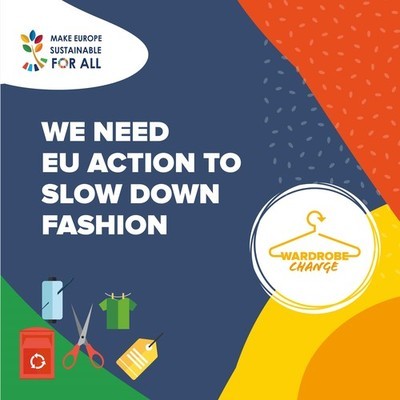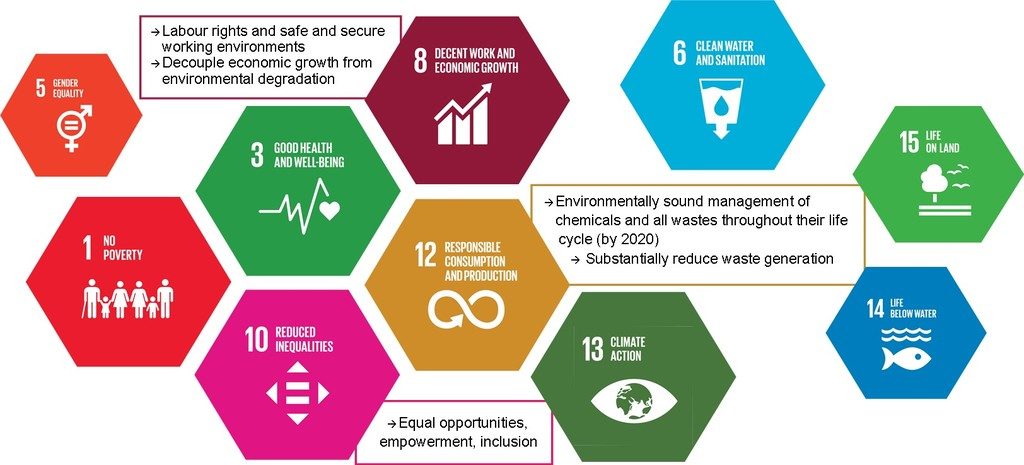Using the hashtag #WardrobeChange, a campaign for the project Make Europe Sustainable For All calls on EU leaders to radically change the textile industry. Since the implementation of the 17 Sustainable Development Goals (SDGs) is closely linked to the modes of production and consumption within the sector, there is an urgent need for concrete measures on an institutional level.
Will the European Commission’s Green Deal be able to meet the related challenges?

The global textile industry is worth around 3 trillion US dollars, making up 2 % of the world’s GDP. It employs several million people, of which 1.7 million are working in Europe alone. However, both the production and the finishing of garments are associated with a number of social and ecological problems:
In a recent report, published in December 2019, the European Environment Agency points out that textile production ranks fourth highest in pressures on the environment and second highest concerning land use. Moreover, the sector’s contribution to CO2 emissions is the fifth highest, with its total of 1.2 annual tons of CO2 exceeding the amount of all greenhouse gas emissions from international flights and maritime shipping combined.
Use of water, chemicals, microplastics
Additionally, highly problematic ecological factors include the vast quantities of water required for production, the use of pesticides, and the extensive use of other chemicals. Moreover, conflicts concerning land use may have repercussions on food security. Another reason for concern lies in the everyday use of textiles: Washing leads to small particles of plastic-based garments being detached and dispersed (but not dissolved) in water – these are so-called microplastics. Each year, half a ton of microplastics are washed down the drain (16 times more than micro beads from cosmetics). So far, these particles are not sufficiently filtered from waste water, creating a danger to fresh water sources and oceans – and thus a danger to humans.
From shopping streets to landfill sites
Cheap items, changing trends, defective quality, and the media-supported desire for Fast Fashion: There are several factors leading garments to be thrown away earlier than necessary, leading to increasing amounts of garbage – in the absence of effective recycling. From the fibres used for production of clothing, a total of 87 % are burned or deposited on landfill sites. This represents a massive loss of resources and complicates efficient solutions for land use and emissions.
Social factors of production
Moreover, production sites for the textile industry are often associated with problematic socio-economic factors: scarce or inexistent labour rights, dangerous working conditions, violations of human rights, and payment that barely covers subsistence needs. The highly publicised fire in a textile factory in Bangladesh (2012) serves as a good example of the often dramatic circumstances, including cases of negligence, when it comes to safety at workplaces and humane work. The retail price does not reflect a garment’s production conditions, especially since factories are sometimes subject to subcontracts and are therefore often overlooked by inspectors. An aggravating factor to all this is the fact that more than three quarters of the clothing industry’s workforce is made up of by women.
SDGs and the textile industry
Looking at the list of problems above, it is obvious that mere

The “European Green Deal” – an ambitious plan
Zero net emissions of greenhouse gases by 2050, curbing pollution, ensuring a just and inclusive transition (“Leave no one behind”) – these topics are not only relevant for the implementation of the SDGs, they are also at the heart of the “European Green Deal“” (EGD), the new EU growth strategy proposed by Ursula von der Leyen. Her outlook: “It will help us cut emissions while creating jobs.” (source).
Measures will focus on particularly resource-intensive sectors (textiles, construction, electronics, and plastics) and will include, among others: putting a stop to intentionally added microplastics, a shift to green public purchasing, the prevention of waste, and new laws against single use plastics EGD (p. 7-9). As an essential part of this strategy, the new Circular Economy Action Plan will emphasise reuse and recycling, and prevent the import of goods that are harmful to the environment. The original action plan, adopted in 2015, was already deemed successful by the Commission in a report (4.3.2020).
Will the EGD solve the problem?
For a successful implementation of the Green Deal, the “The European Green Deal Investment Plan“” will be crucial. The plan aims at mobilising at least €1 trillion of investments (by strategically using the EU budget and stimulating external investments). However, the coherence and scope of implemented laws will determine whether measures will simply transfer problems to other countries, or if they will have the desired effect.
In this context, not only the role model function of the EU should be considered: Besides economic risks, stricter regulations on non-sustainable products and social standards may possibly lead to an international adoption of stricter requirements (California Effect).
Furthermore, the Commission’s plans to tackle false claims about environmentally friendly products (so-called “greenwashing”) play a significant role: A standard method to assess environmental impacts and penalties for false claims should contribute to more reliable and comparable information, according to EGD (p. 8). This type of standardised, Europe-wide benchmarks surely represents an important prerequisite for future measures and might bring about better transparency for consumers.
Still, are higher standards and enhanced energy and resource efficiency going be enough in the long run, while consumption habits and economic models stay the same?
“Clean” and recyclable/reusable products are only environmentally friendly if they are actually reused or recycled – and as long as the efficiency gains are not cancelled out by a subsequent rise in consumption. This is why the promotion of repair services and platforms for exchange and resale (e.g. by granting tax benefits), as well as enhanced sorting and recycling of waste, are just as important for a circular economy as global regulations for production. Let�s hope that a facilitation of re-use and repair, as mentioned in both the EGD and the Circular Economy Action Plan, will soon be addressed with concrete measures.
What can I do?
As consumers, we can also contribute to a more sustainable fashion industry by changing our habits and demanding coherent action in line with the Commission’s Green Deal – a #WardrobeChange has been overdue for a long time.
- Spread information
We need to inform others about the hidden costs of the textile industry. Share the #WardrobeChange video or this article on Social Media. - Try to avoid waste by repairing and re-using things:
– Have you thought about organising a clothes swapping party instead of your next shopping trip?
– Browse local secondhand stores, instead of buying new clothes online.
– Find out if the item you are looking for is for sale on an online marketplace for used fashion.
– Make use of repair services, visit Repair-Cafés or DIY workshops. - Pay attention to fair production standards:
Several websites (like the Clean Clothes Campaign’s) inform you about ethically produced brands and sustainable shops in your area.
Links
- EU project Make Europe Sustainable For All
- Campaign #Wardrobe Change
- The European Green Deal
- EU website on Circular Economy
- New Circular Economy Action Plan
- Clean Clothes Campaign
- Environmental standards in the textile and shoe sector
- Fashion Footprint Calculator

Caroline Krecké, ÖKOBÜRO / SDG Watch Austria
Caroline is a freelance translator/editor and currently works for ÖKOBÜRO and SDG Watch Austria in the fields of communications and sustainable development. She studied at the University of Vienna and the University of Natural Resources and Life Sciences, Vienna. Her professional and personal interests lie in sustainability, environmental protection, and societal challenges.
ÖKOBÜRO and a number of other organisations are engaged in the campaign Wardrobe Change, forming part of the project Make Europe Sustainable for All (all related activities and updates will be published on the campaign's website). SDG Watch Austria also hosts an initiative on sustainable economy.
Note: A version of this article was published on sdgwatch.at on 24.2.2020.


